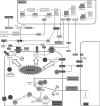Dynamics of unfolded protein response in recombinant CHO cells
- PMID: 24504562
- PMCID: PMC4329310
- DOI: 10.1007/s10616-013-9678-8
Dynamics of unfolded protein response in recombinant CHO cells
Abstract
Genes in the protein secretion pathway have been targeted to increase productivity of monoclonal antibodies in Chinese hamster ovary cells. The results have been highly variable depending on the cell type and the relative amount of recombinant and target proteins. This paper presents a comprehensive study encompassing major components of the protein processing pathway in the endoplasmic reticulum (ER) to elucidate its role in recombinant cells. mRNA profiles of all major ER chaperones and unfolded protein response (UPR) pathway genes are measured at a series of time points in a high-producing cell line under the dynamic environment of a batch culture. An initial increase in IgG heavy chain mRNA levels correlates with an increase in productivity. We observe a parallel increase in the expression levels of majority of chaperones. The chaperone levels continue to increase until the end of the batch culture. In contrast, calreticulin and ERO1-L alpha, two of the lowest expressed genes exhibit transient time profiles, with peak induction on day 3. In response to increased ER stress, both the GCN2/PKR-like ER kinase and inositol-requiring enzyme-1alpha (Ire1α) signalling branch of the UPR are upregulated. Interestingly, spliced X-Box binding protein 1 (XBP1s) transcription factor from Ire1α pathway is detected from the beginning of the batch culture. Comparison with the expression levels in a low producer, show much lower induction at the end of the exponential growth phase. Thus, the unfolded protein response strongly correlates with the magnitude and timing of stress in the course of the batch culture.
Figures








Similar articles
-
Activation of unfolded protein response pathway is important for valproic acid mediated increase in immunoglobulin G productivity in recombinant Chinese hamster ovary cells.J Biosci Bioeng. 2017 Oct;124(4):459-468. doi: 10.1016/j.jbiosc.2017.05.005. Epub 2017 Jun 7. J Biosci Bioeng. 2017. PMID: 28601608
-
ATF6β-based fine-tuning of the unfolded protein response enhances therapeutic antibody productivity of Chinese hamster ovary cells.Biotechnol Bioeng. 2017 Jun;114(6):1310-1318. doi: 10.1002/bit.26263. Biotechnol Bioeng. 2017. PMID: 28165157
-
Multiplexed Digital mRNA Expression Analysis Profiles System-Wide Changes in mRNA Abundance and Responsiveness of UPR-Specific Gene Expression Changes During Batch Culture of Recombinant Chinese Hamster Ovary Cells.Biotechnol J. 2018 Mar;13(3):e1700429. doi: 10.1002/biot.201700429. Epub 2018 Feb 2. Biotechnol J. 2018. PMID: 29323465
-
The multiple roles of the unfolded protein response regulator IRE1α in cancer.Mol Carcinog. 2019 Sep;58(9):1623-1630. doi: 10.1002/mc.23031. Epub 2019 Apr 30. Mol Carcinog. 2019. PMID: 31041814 Free PMC article. Review.
-
Dual role of Endoplasmic Reticulum Stress-Mediated Unfolded Protein Response Signaling Pathway in Carcinogenesis.Int J Mol Sci. 2019 Sep 5;20(18):4354. doi: 10.3390/ijms20184354. Int J Mol Sci. 2019. PMID: 31491919 Free PMC article. Review.
Cited by
-
Harnessing secretory pathway differences between HEK293 and CHO to rescue production of difficult to express proteins.Metab Eng. 2022 Jul;72:171-187. doi: 10.1016/j.ymben.2022.03.009. Epub 2022 Mar 14. Metab Eng. 2022. PMID: 35301123 Free PMC article.
-
An optimized genome-wide, virus-free CRISPR screen for mammalian cells.Cell Rep Methods. 2021 Aug 23;1(4):100062. doi: 10.1016/j.crmeth.2021.100062. Epub 2021 Aug 4. Cell Rep Methods. 2021. PMID: 34935002 Free PMC article.
-
Protein-Specific Signal Peptides for Mammalian Vector Engineering.ACS Synth Biol. 2023 Aug 18;12(8):2339-2352. doi: 10.1021/acssynbio.3c00157. Epub 2023 Jul 24. ACS Synth Biol. 2023. PMID: 37487508 Free PMC article.
-
RNASeq highlights ATF6 pathway regulators for CHO cell engineering with different impacts of ATF6β and WFS1 knockdown on fed-batch production of IgG1.Sci Rep. 2024 Jun 19;14(1):14141. doi: 10.1038/s41598-024-64767-1. Sci Rep. 2024. PMID: 38898154 Free PMC article.
-
Development of a fluorescent reporter system for monitoring ER stress in Chinese hamster ovary cells and its application for therapeutic protein production.PLoS One. 2017 Aug 23;12(8):e0183694. doi: 10.1371/journal.pone.0183694. eCollection 2017. PLoS One. 2017. PMID: 28832690 Free PMC article.
References
LinkOut - more resources
Full Text Sources
Other Literature Sources
Research Materials

